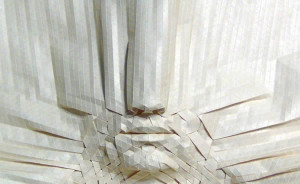 Torah Sparks
Torah Sparks
Exodus 30:11 – 34:35
Following immediately after our celebration of the raucous holiday of Purim, we can read this Torah portion and notice a couple of elements that bear comparison with elements of the Purim story and observance. One element is that of celebration itself. Parties play a key role in the Purim story. The Megillah opens with a large, state-sponsored party and proceeds with many others, each one marking an important step in the unfolding of the story. In our Torah portion we read of one party that had disastrous consequences, the celebration around the Golden Calf: “The people sat down to eat and drink and then they rose to party.” (Ex. 32:6) Such a parallel can serve to make us think about the nature of partying, with its positive and its negative aspects. It could, but, actually, on Purim we simply prefer to have a good time.
Another echo of Purim in our portion is the motif of wearing a mask. Wearing costumes and masks is a beloved part of Purim observances. We take great delight in playing with elaborate or funny transformations of ourselves and our friends and children. Wearing a mask allows us to imagine that we can be someone other than who we are, while, at the same time, hoping that people will still be able to tell that it is, indeed, we who came up with the wonderful costume we wear. The mask plays an ambiguous role of concealing and revealing, of hiding ourselves and of embellishing ourselves, and of emboldening ourselves to act more freely than we might otherwise allow ourselves to act. Part of the Purim experience is to gently touch upon such difficult issues but then to quickly slide away from them, back into the realm of the frivolous. Purim masks are to enjoy, not to philosophize over.
So it is striking to read that Moses also wore a mask. This happened after Moses had succeeded in bringing about a reconciliation between God and Israel after the Golden Calf tragedy. Moses draws close to God and pleads that God forgive the people. God agrees. And then a new set of Tablets of the Torah are given. Nevertheless, for a while Moses moves out of the encampment to be alone with God and to allow the Israelites to recover from their sense of failure and betrayal of God. Moses refrains from publicly teaching Torah to the masses. Instead, only when an Israelite could summon up the courage to approach Moses and ask him to instruct him in God’s Torah, only then would Moses accede to their request. And the Torah continues: “And when he finished speaking with them he would place a mask on his face. And when Moses would enter before God to speak with Him, he would remove the mask until he left. He would leave and tell the Israellites what he was commanded.” (Ex. 34:33-34)
What was the role of Moses’s mask? Why did Moses have to hide his face? When did he wear it and when did he remove it? The simplest reading of this ambiguous text (not adopted by most traditional commentators – but that is for another time) is that he wore the mask outside of the Tent of Meeting, but not when he was alone with God. We recall that earlier in this Torah portion God tells Moses that no one can see God’s Face and live. And, immediately before we are told about the mask, we learn that Moses’ face was radiating beams of light and that the Israelites ran away from him in fright. Is Moses copying God’s nature and covering his face in deference to the terror of the Israelites? Did the people of Israel hear Moses’ teaching from behind a veil? Was Moses able to expose his true self only when he was in private communion with God? Unlike the apparently fun masks of Purim, Moses’ mask conveys a deeper mystery.
Shabbat Shalom
Rabbi David Greenstein
image: “Mask in Progress” © Joel Cooper altered and used with permission via Creative Commons License 2.0
- Toby Stein: In Memoriam - Thu, Feb 8, 2024
- Faithfulness and Hope: Parashat Sh’lach - Thu, Jun 23, 2022
- Past Their Prime: Parashat B’ha`a lot’kha - Thu, Jun 16, 2022
